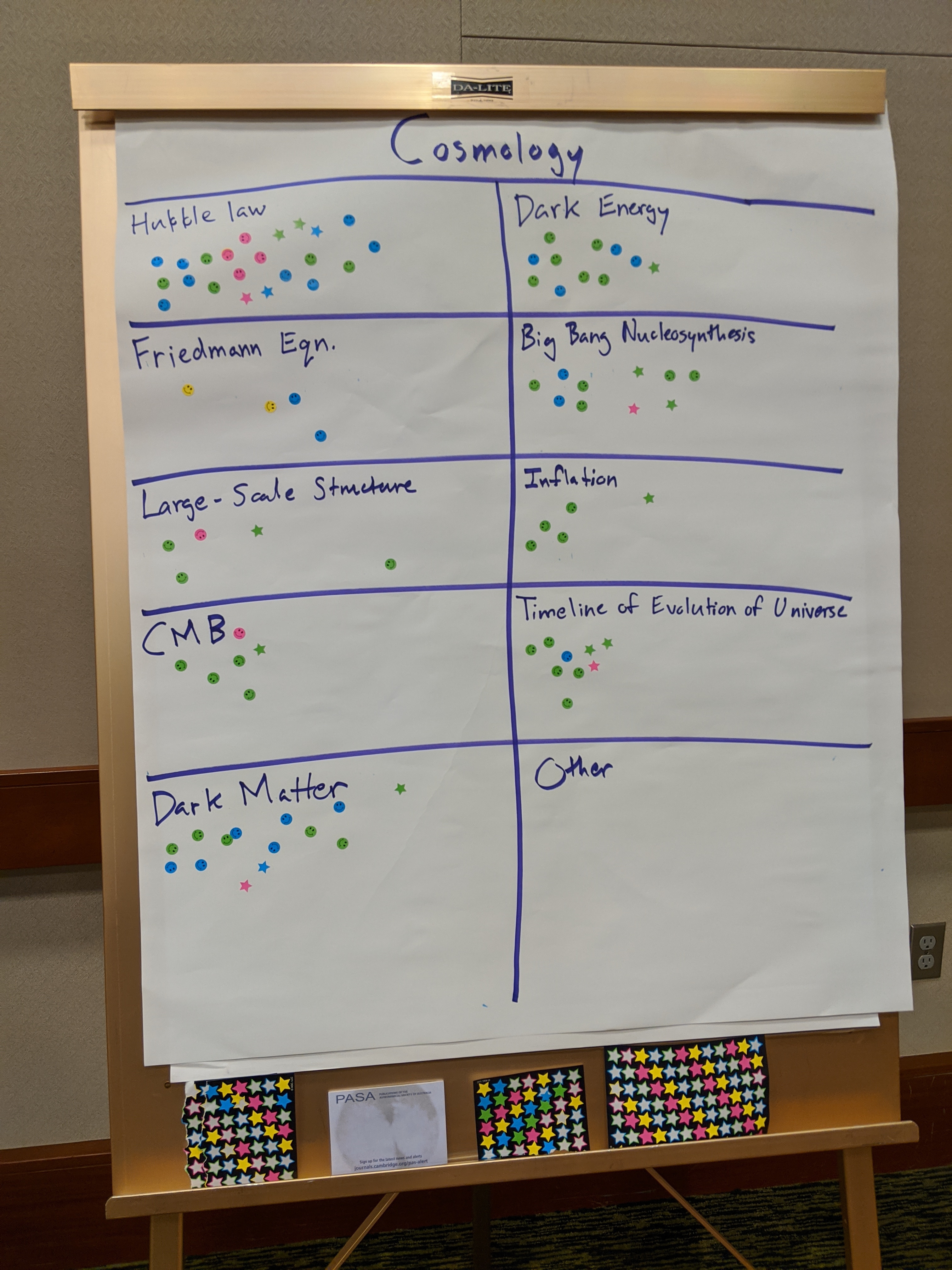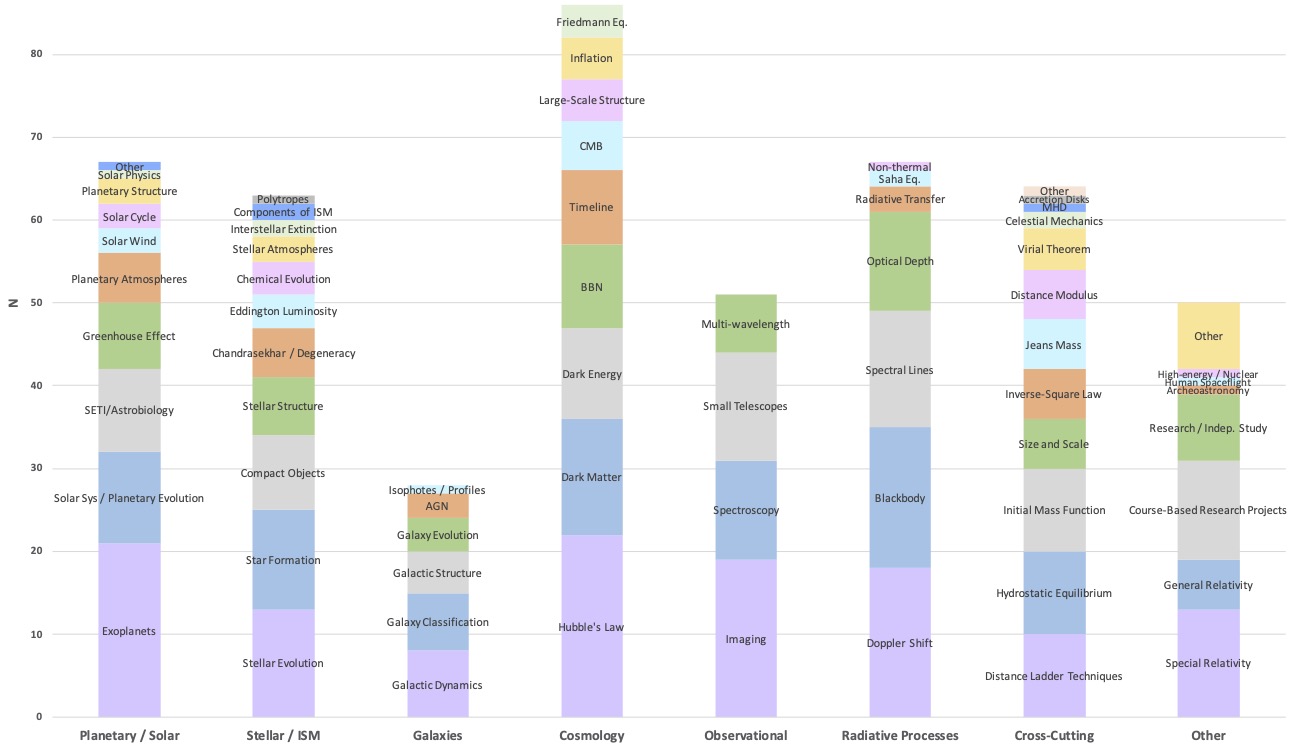What Do We Expect Undergraduate Astronomy Majors to Learn?
Colin Wallace University of North Carolina, Chapel Hill
Kimberly Coble San Francisco State University
Janelle Bailey Temple University
According to the American Institute of Physics (AIP), over 500 students graduate each year with a bachelor’s degree in astronomy — and that number is growing. What are we teaching these students and why? How are they being taught? How might this be informed by education research? Surprisingly, the answers to these questions are not clear. Fortunately, multiple groups are working to address these issues, including the AAS Education Committee and astronomy education researchers. In this post, we will discuss recent efforts to ascertain the “what” and the “how” of learning in upper-division undergraduate astronomy courses.
Background
Unlike physics, where there is an established canon of courses that all majors take (e.g., classical mechanics, electricity and magnetism, quantum mechanics, etc.), astronomy degree requirements vary widely from institution to institution. According to a 2003 survey by Cabanela and Partridge, the only courses required by all astronomy bachelor’s programs are two semesters of introductory physics and the necessary calculus prerequisites. Compounding this lack of consensus on curriculum is a dearth of research-based instructional (active learning) materials appropriate for upper-division astronomy courses.
Physics education researchers have established extensive literature on student learning at all levels. This literature informs and supports the development of research-based instructional materials, strategies, and assessments, available for instructors to use across the canon of physics courses (more resources are listed at the end of this post). While much astronomy education research has focused on general education introductory courses, our physics colleagues’ work shows that research-based instructional strategies work for students at all levels; it’s not limited to non-STEM majors, or to introductory students, or to non-quantitative content, but includes upper-division students and courses as well. Decades of research show that students learn more and retain what they learn for longer periods of time when they are taught with active learning techniques rather than traditional, lecture-only instruction. Furthermore, traditional, lecture-only instruction widens achievement gaps, disadvantages some groups of students relative to others, and fails to achieve the same level of learning gains that are possible with research-based instructional practices, including in astronomy.
Toward Research-Informed Curricula for Astronomy Majors
To be blunt: We have an obligation to infuse active learning and other research-based instructional strategies into courses for astronomy majors. How can we get there? Several significant steps have been taken recently, originating at the 235th AAS Meeting in Honolulu, Hawai‘i (4-8 January 2020):
- The AAS Education Committee forum on Majors’ Curriculum
- The “AMPlifying Your Majors’ Courses: From Unpacking to Problem Solving” workshop supported by an AAS EPD Mini-Grant
- Creation of a survey on common curricular practices and needs
The Forum
The goal of the Education Committee’s forum was to learn what is taught and how in upper-division astronomy/astrophysics courses, understand the needs of the instructors of these courses, and guide future education research and curriculum development efforts for astronomy/astrophysics majors (and minors/concentrations).
Prior to the forum, the authors of this post created a list of topics (e.g., radiative processes, cosmology, galaxies, stellar/ISM, planetary/solar, observational techniques, cross-cutting, etc.) and each topic was subdivided into several sub-topics. There is nothing sacrosanct about the topics and sub-topics we selected and how we organized them; their purpose was merely to serve as a conversation starter among the forum’s participants.
After a brief introduction, forum participants engaged in a “big paper” activity to identify current components of their institutions’ curricula for astronomy majors. Participants moved around the room, placing different colored stickers on paper lists of topics depending on how each sub-topic was addressed — i.e., blue for quantitative problem-solving, green for conceptual, pink for observational, and yellow for computational. There was also plenty of room for other topics and sub-topics to be listed by participants.

These results prompted broader discussion during the forum about which topics must be included in a program for astronomy majors and which are not essential. Some topics (e.g., blackbody radiation, Hubble’s law, etc.) are clearly important to many astronomy programs, while others appear to be of lesser importance across programs (e.g., non-thermal radiation, accretion disks, etc.). After the forum, we tallied frequency counts for each sub-topic.

Participants in the forum also engaged in a Think-Pair-Share “index card” activity where they brainstormed what would be most helpful in better supporting their courses for astronomy majors. Common needs included (but were not limited to): computational problem sets and projects, authentic scientific data in student-friendly formats, tutorials that interleaved quantitative and qualitative problem-solving, concept-test (“clicker”) questions, training on how to access and contribute existing materials in clearinghouses such as ComPADRE and PhysPort, and, not surprisingly, considerably more time, resources, equipment, facilities, and support for course reform.
The AMP Workshop
The day after the forum, Rica French, Ed Prather, and Colin Wallace ran a workshop entitled “AMPlifying Your Majors’ Courses: From Unpacking to Problem Solving.” This workshop was made possible by an AAS EPD Mini-Grant. The “AMP” in the first word of the title is not a typo; it is a playful combination of the word “amplify” and the acronym “AMP,” which stands for Astronomy Majors Project. At the start of the workshop, we asked participants to work with a partner to develop a top 10 list of knowledge and abilities that astronomy majors should learn from solving quantitative problems. Some of the responses we received include:
- Calculate the radius of a Strömgren sphere given parameters such as ionizing flux and density;
- Use approximate solutions to the stellar structure equations to derive scaling relationships for stars;
- Calculate the scale height of a planetary atmosphere for a specific element and planet mass;
- Integrate an initial mass function to determine the fractional number of stars formed in a given mass range;
- Use the Planck function to derive the Stefan-Boltzmann and Wein laws.
Next, we introduced participants to a framework developed from French and Prather’s research that enables instructors to generate engaging contexts and representations for active learning curricula. We gave examples of existing active learning curricula for astronomy majors’ courses, such as a Lecture-Tutorial on galactic star-formation rate (written by Jeremy Bailin and Ed Prather) and a series of quantitative Think-Pair-Share questions (written by Colin Wallace) to help students understand the derivation of the pressure integral.
Finally, we asked participants to collaborate with one another to develop a quantitative problem (and the necessary representations) that they think their majors should be able to answer by the time they graduate. The questions participants generated included the following:
- If a star has an effective temperature of 8450 K, should the Ca II absorption lines be strong or weak? What about H-alpha?
- If a star about 3 times the mass of the Sun collapses after consuming all its nuclear fuel, it forms a degenerate gas of neutrons. Assuming the star is completely composed of neutrons, calculate the equilibrium radius of the neutron star that forms (i.e., gravity is balanced by neutron degeneracy pressure).
- Below are observations of two Cepheid variable stars that were observed in the same galaxy. What is the distance to that galaxy? Use the plot of Leavitt’s period-luminosity relation below. [Note: The observational data and Leavitt’s Law were provided, but are not reproduced here.]
The top 10 lists and sample questions created by participants give us additional insights, beyond those gained during the forum, regarding what AAS members think astronomy majors should learn.
Take the Survey!
The conference sessions described above gave us an idea of the topics and techniques astronomers consider important for astronomy majors to learn. A more comprehensive survey of the nation’s undergraduate astronomy programs would reveal the extent to which the results described above accurately capture the nationwide profile of topics taught to astronomy majors and would provide an important update to the 2003 study of Cabanela and Partridge.
Based on the activities and discussions at the forum, the AAS Education Committee has created a survey on common curricular practices and needs. Questions include the institution and program types, which sub-topics are covered and how in the curriculum, current needs for support. There is an option for email contact if you would like to discuss your program with us in more detail.
Take the survey and spread the word: we would love to have your input!
Next Steps
We advocate for establishing a community of interested researchers and educators focused on developing, implementing, and assessing active learning curricula appropriate for upper-division astronomy courses. This effort will involve conducting astronomy education research to identify students’ conceptual, reasoning, and problem-solving assets and challenges, as well as assessing the impact and efficacy of any curricula we develop. However, we must involve more than just astronomy education researchers. We will need participation from the broader AAS community. If we are to have a positive, long-lasting effect on teaching and learning in our undergraduate classes, then we must involve the various stakeholders in those classes so that the curricula we develop are compatible with their goals.
The work described above is substantial. Yet everyone will benefit if we are successful. Instructors, especially first-time instructors, will appreciate having research-based instructional materials to help achieve their pedagogical goals and support a diverse student body. Students will learn more. The broader community of AAS members and astronomers in general will benefit from better-prepared undergraduates.
Additional resources:
- AAS resources for educators at all levels, which include links to the physics and astronomy education research literature, compilations of curricula, task force recommendations, and more.
- AAS list of departments offering astronomy-related degrees
- AIP roster of astronomy departments
- ComPADRE astronomy center: resources and materials (for ASTRO 101)
- University of Colorado active learning materials for upper-division physics courses
- PhysPort’s list of assessments appropriate for upper-division physics courses
- Paradigms in Physics Curricula Materials website

